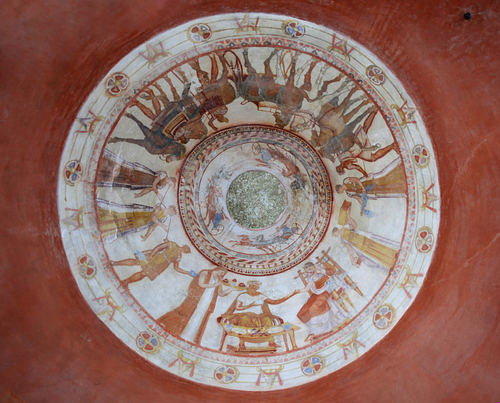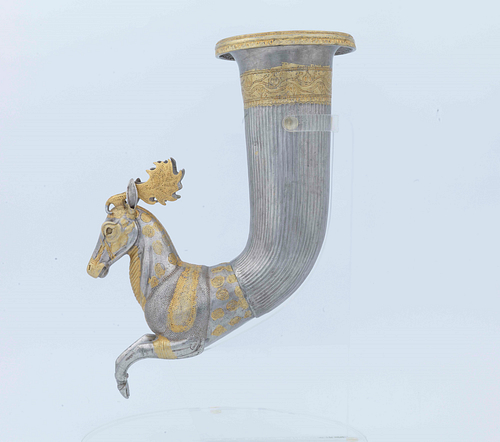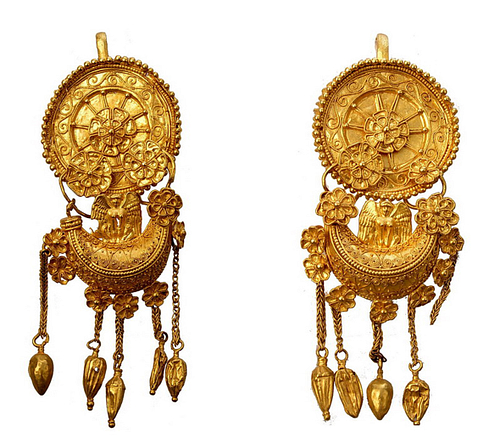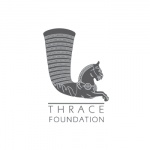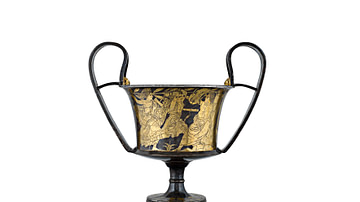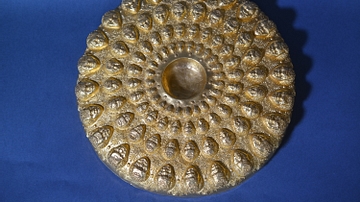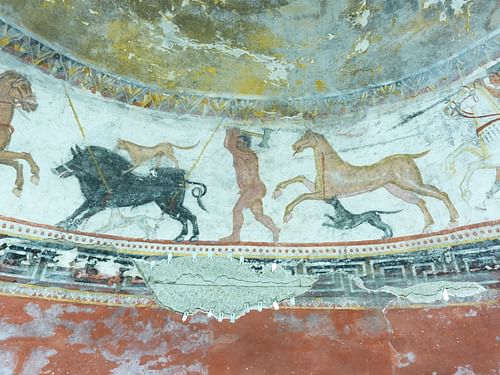
The art produced by the people of Thrace, as indicated by the many precious objects found in Thracian tombs dating from the Bronze Age onwards, was, like the culture itself, a mix of indigenous ideas and foreign influences. Although it can be difficult to distinguish local and imported high-value objects, typical features of Thracian Art are the use of brightly coloured wall paintings to decorate tombs, the widespread use of metal vessels, especially for the burial of the deceased's remains, and intricately manufactured jewellery pieces in precious metals. Finally, there was a particular appreciation for Greek black-figure pottery, with many of the finest examples of that genre surviving in Thracian tombs.
Thrace
The Thracian people were one of the oldest inhabitants of the vast territories of Eastern and Southeastern Europe during the late second and first millennia BCE, until they were gradually conquered by the Roman Empire in the 1st and 2nd centuries CE. Sadly, they failed to develop their own literacy, thus they left no written record of their history. Most of our knowledge of them nowadays is derived from Greek and Roman sources, many of which are of questionable accuracy, and more importantly from archaeological remains still found today in Thracian territories.
In order to grasp the significance of this longstanding culture, we are highly dependant on the legacies that ancient Thracians left behind in the form of visual data such as tomb decorations, metal vases, pottery, precious adornments and others. An in-depth look at the artefacts and archaeological finds creates an elaborate picture of the role that art played in the Thracian culture.
As a civilization composed of many independent communities (or tribes), situated on a crossroad between Europe and Asia, Thrace and its cultural development were a subject of constant alterations and foreign influences. Therefore any attempt to look at Thracian art as a homogenous and unaffected phenomenon would not be entirely accurate.
Tomb Painting
The deceased Thracians were either buried or cremated, and their remains were deposited in various burial structures ranging from basic pits in the ground to built graves, sarcophagi or monumental chamber tombs, which are found buried beneath a mound. The Thracian people held strong beliefs in the afterlife and naturally the interiors of such burial spaces were arranged accordingly to serve as an intermediate sacral space between this life and the next, provided with everything the deceased would need to continue his or her spiritual journey.
Often the walls of earlier tombs were decorated with simplified monochrome paintings in red and white colours, made from organic materials and continuously used throughout antiquity. Ever since prehistoric times the colour red and its hues were associated with death where a funerary context was concerned, and in tomb paintings red was used to depict the head and the torso of the human body, emphasizing their physical importance as containers of the soul and mind.
Some later examples of tomb paintings present more complex figural scenes and finer ornamentation with a more vibrant palette of white, black, red and yellow pigments. Scenes of everyday life, such as hunts, feasts, marital scenes were commonly present as well as various mythological and funerary themes. All of the aforementioned motifs can be traced back to the Archaic period and they were a fundamental part of the funerary iconography of the whole eastern Mediterranean region. The decoration of Thracian tombs varied significantly depending on the geographical location and its ethnic, political, commercial and cultural relations with near or distant cultures.
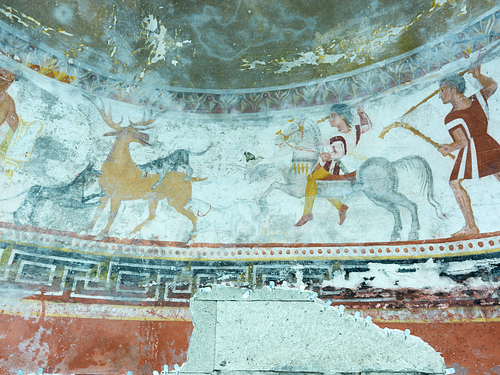
Metal Vases
Large numbers of metal vases of exquisite quality are regularly found during archaeological excavations on what was once supposed to be Thracian territories. They likely served a long life as prestigious objects of wealth and power, used during important occasions or sacred feasts before they were eventually placed in the ground. The abundance of such precious vessels in every rich burial suggests that in the Thracian culture they were also essential attributes that were to assist the deceased in the prospective afterlife and further ensure the continuity of his status and prosperity in the next life.
Small vessels, often part of drinking sets used in feasts or religious rites and ceremonies, such as phialai, bowls, rhyta, jugs, and strainers were frequently made of precious metals like gold or silver. Bronze, although often used as a substitute for gold, was also considered an expensive material, available only for the elite and was most commonly used for vessels larger in size such as hydriai, situlae, basins, craters, and pitchers. Large bronze vessels are repeatedly found in the graves of wealthy Thracians, serving as burial urns for the ashes of the deceased.
A frequently occurring shape in Thrace was the phiale, a concave shallow bowl without handles and generally with a central omphalos (navel). In everyday life, some deep phialai were used as wine drinking cups, but, in general, they served an important ritual function when pouring libations for the gods or deceased ancestors. Both the Achaemenid type phiale with glaring offset rim and shallow depth and the straight-rimmed Greek shape were familiar in Thrace. Many Thracian workshops adopted some of the foreign stylistic features but also incorporated their local stylistic traditions.

Another type of drinking vessel and essential component of the Thracian culture was undoubtedly the rhyton, a horn-shaped vessel usually terminating in an animal forepart or head and a little spout at the lower end for pouring liquid out. Rhyta were ceremonial vessels, used for libations during drinking parties. The large number found in Thrace suggests that they were popular among Thracian princes and dignitaries.
It is important to note, however, that precious vessels found in Thrace were not always of local production. The Thracian aristocracy constantly enjoyed foreign imports, produced in various workshops all over the ancient art world from the pre-Achaemenid Anatolia to Classical Greece, and from Etruria to the Hellenized East. Some of them were brought by Athenian delegations as diplomatic gifts to the local Thracian tribal chiefs to secure trade of sought-after goods, such as precious metals, timber and animal furs. Other such valued possessions arrived through commerce or as a substitute of payment when transacting with the tribes. Last but not least, a frequent acquisition of prized vessels often took place in the form of war spoils.
Pottery
Pottery shapes of ancient Thrace were extremely variable and constantly shifted in line with the overall trend of the ancient Mediterranean world at the time; therefore many technological and stylistic groups could be defined.
The earliest pottery examples found in Thracian territories, dating back to the Bronze Age, were predominantly handmade, quite primitive in appearance and the clay contained many impurities. Pottery was rather produced in a domestic setting than in a workshop. The predominant shapes comprised various types of bowls, jugs, pitchers, kantharoi, cups and storage containers, and all of them were utilized in the everyday life of Thracians. The decoration was relatively simple with various motifs arranged in geometric pattern combinations through incision or stamping.
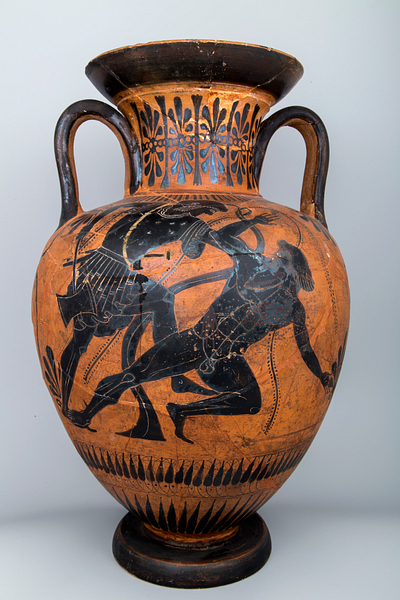
During the Late Archaic and Classical periods, wheel-made pottery gradually appeared in some regions of Thrace. Thracian potters managed to improve the quality of the pots, using clay with fewer impurities. The overall shape became more refined, and some foreign influences were incorporated in the design.
One particular group of vessels was more predominant, and this was Monochrome pottery, often referred to as “Grey pottery”. A distinct feature of this type was the usually burnished surface with a glossy, greyish to black colour. Perhaps this type was the most abundant category of tableware in ancient Thrace, and its use lasted until Hellenistic times.
Other archaeological finds dating to the Classical period also showed an abundance of imported Greek black and red figure decorated vases, especially those from Greek colonies, occupying parts of the North Aegean and the Black Sea coasts. The plentiful discovery of vessels in that region presents a greater variety of shapes like column craters, bell craters, hydriai, lekythoi, and pelikai. The decorative scenes favoured by Thracians were those manifesting religious or funerary beliefs.
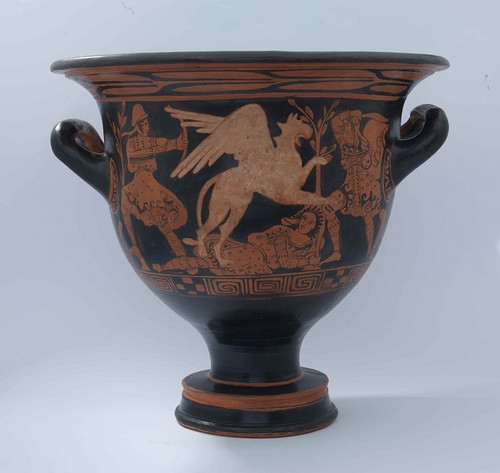
During the Hellenistic period, Тhracian pottery went through significant changes. The popularity of Grey Monochrome pottery was gradually replaced with several other stylistic groups, such as Plain Red pottery, Black-glaze pottery, and West Slope pottery.
Jewellery
Thracians were particularly skilled at making precious jewellery. Among the Thracians, elite adornments were not just seen as simple ornamentation, but rather, decorating the body and dress with precious objects played an essential role in demonstrating the status and wealth of the wearer and in emphasizing the religious and ceremonial functions performed by the individual.
The earliest jewellery examples found in Thrace represent adornments predominantly associated with dress, such as small fibulae and pendants made from bronze, iron, silver and more rarely gold. Occasional finds of bracelets and earrings were usually somewhat crude and heavy in appearance, made of bronze or amber beads.
Later in Classical times, a period of gradually emerging states and aristocracy in Thrace, jewellery attained an essential function as a mark of political and social status, available only to the elite. The design of the precious adornments drastically changed and new Greek-style forms were introduced. Earring, bracelets, and rings were now produced mainly in gold and foreign decorative techniques, such as casting, repoussé and filigree were employed by Thracian artisans and goldsmiths.
After the mid 4th century BCE the Greek-style fashion gradually evolved until Thracian jewellery almost entirely adapted Hellenistic traditions, including the use of incrustation, enamel, and polychrome with newer and fashionable Greek forms and designs.
